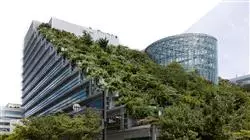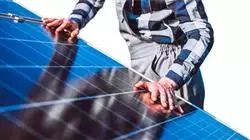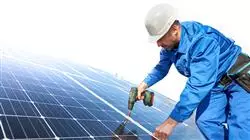University certificate
The world's largest faculty of engineering”
Description
Acquire the most advanced and up to date knowledge in the field of Building Rehabilitation and Energy Saving with a Professional Master's Degree of high qualification and educational impact"

This Professional Master's Degree effectively combines the technical and technological knowledge of projects and construction necessary to develop a project or work based on the necessary energy saving measures, whether in the field of intervention in existing buildings (Energy Rehabilitation) or new construction (Energy Saving).
It establishes a work dynamic that enables the student to develop projects of different scales with maximum rigor analyzing the different intervention options, either through passive measures (affecting the building envelope) or based on active measures (affecting the building's systems and installations).
The exposure of success stories that develop the objective in a clear and concise way, able to extrapolate it to future projects with maximum requirements of Energy Saving.
In addition, the guidelines for checking the current state of the existing building under current regulations (Energy Audit), technical requirements based on the latest regulatory changes (Technical Code 2019) as well as a very precise and technical development of the intervention measures to optimize the energy demand of the building are established.
The fundamentally practical qualification of the team that teaches the master offers a precise vision of analysis of each of the intervention measures in buildings based on their best energy performance.
During the development of the Professional Master's Degree, the analysis of the possible measures to be developed in a Rehabilitation / Energy Saving project will be carried out based on the experience of singular works and real success cases, analyzing the different options of intervention in the energy field concerning materials, systems and installations of high energy performance.
On the other hand, the bases for the development of cost control analysis and selection of appropriate intervention option in the development of project and work are integrated, as well as the analysis of the control of the rigor of the objective based on the quality of the construction.
With this Professional Master's Degree in Rehabilitation and Energy Saving in Buildings you will be educated in the latest trends of the sector related to maximum Energy Saving and Sustainability, obtaining a wide knowledge of the development options and requirements in the international field.
An intensive and comprehensive study of the development options and energy efficiency requirements that apply in the international field"
This Professional Master’s Degree in Rehabilitation and Energy Saving in Building contains the most complete and up-to-date program on the market. The most important features include:
- Latest technology in online teaching software
- Highly visual teaching system, supported by graphic and schematic contents that are easy to assimilate and understand
- Practical cases presented by practicing experts
- State-of-the-art interactive video systems
- Teaching supported by telepractice
- Continuous updating and recycling systems
- Self-regulating learning: full compatibility with other occupations
- Practical exercises for self-evaluation and learning verification
- Support groups and educational synergies: questions to the expert, debate and knowledge forums
- Communication with the teacher and individual reflection work
- Content that is accessible from any fixed or portable device with an Internet connection
- Supplementary documentation databases are permanently available, even after the course
Learn how to develop projects of various scales by analyzing the different optimization options, through passive or active measures and give your projects the energy quality that the market demands"
Our teaching staff is made up of professionals from different fields related to this specialty. In this way, we ensure that we provide you with the educational update we are aiming for. A multidisciplinary team of professionals qualifed and experienced in different environments, who will develop the theoretical knowledge in an efficient way, but above all, they will bring their practical knowledge from their own experience to the course: one of the differential qualities of this program.
This mastery of the subject matter is complemented by the effectiveness of the methodological design. Developed by a multidisciplinary team of e-learning experts, it integrates the latest advances in educational technology. This way, you will be able to study with a range of comfortable and versatile multimedia tools that will give you the operability you need in your specialization.
The design of this program is based on Problem-Based Learning: an approach that conceives learning as a highly practical process. To achieve this remotely, we will use telepractice learning: with the help of an innovative interactive video system, and learning from an expert, you will be able to acquire the knowledge as if you were actually dealing with the scenario you are learning about. A concept that will allow you to integrate and fix learning in a more realistic and permanent way.
An immersive experience, which will provide you with a faster integration and a much more realistic view of the contents through the observation of experts acting on the subject studied"

Include in your knowledge, the exhaustive analysis of real success cases, in a contextual and direct learning"
Syllabus
The contents of this Professional Master's Degree have been developed by the different experts participating in it, with a clear purpose: to ensure that our students acquire each and every one of the skills necessary to become true experts in this field. A complete and well-structured program that will take you to the highest standards of quality and success.

A comprehensive teaching program, structured in well-developed teaching units, oriented towards learning that is compatible with your personal and professional life"
Module 1. Energy Rehabilitation of Existing Buildings
1.1. Methodology
1.1.1. Main Concepts
1.1.2. Establishment of Building Categories
1.1.3. Analysis of Construction Pathologies
1.1.4. Analysis of the Objectives of the Regulations
1.2. Study of Pathologies of Foundations of Existing Buildings
1.2.1. Data Collection
1.2.2. Analysis and Evaluation
1.2.3. Proposals for Improvement and Conclusions
1.2.4. Technical Regulations
1.3. Study of Roof Pathologies in Existing Buildings
1.3.1. Data Collection
1.3.2. Analysis and Evaluation
1.3.3. Proposals for Improvement and Conclusions
1.3.4. Technical Regulations
1.4. Studies of Pathologies of Facades of Existing Buildings
1.4.1. Data Collection
1.4.2. Analysis and Evaluation
1.4.3. Proposals for Improvement and Conclusions
1.4.4. Technical Regulations
1.5. Studies of Pathologies of Exterior Floor Slabs of Existing Buildings
1.5.1. Data Collection
1.5.2. Analysis and Evaluation
1.5.3. Proposals for Improvement and Conclusions
1.5.4. Technical Regulations
1.6. Studies of Pathologies of Carpentry and Glazing in Existing Buildings
1.6.1. Data Collection
1.6.2. Analysis and Evaluation
1.6.3. Proposals for Improvement and Conclusions
1.6.4. Technical Regulations
1.7. Analysis of Existing Building Installations
1.7.1. Data Collection
1.7.2. Analysis and Evaluation
1.7.3. Proposals for Improvement and Conclusions
1.7.4. Technical Regulations
1.8. Study of Energy Rehabilitation Interventions in Historic Buildings
1.8.1. Data Collection
1.8.2. Analysis and Evaluation
1.8.3. Proposals for Improvement and Conclusions
1.8.4. Technical Regulations
1.9. Economic Study of Energy Rehabilitation
1.9.1. Cost Analysis
1.9.2. Time Analysis
1.9.3. Specialization of the Works
1.9.4. Guarantees and Specific Tests
1.10. Evaluation of Appropriate Intervention and Alternatives
1.10.1. Analysis of the Different Intervention Options
1.10.2. Cost Analysis Based on Amortization
1.10.3. Target Selection
1.10.4. Final Assessment of the Selected Intervention
Module 2. Energy Saving in New Buildings
2.1. Methodology
2.1.1. Establishment of Building Categories
2.1.2. Analysis of Construction Solutions
2.1.3. Analysis of the Objectives of the Regulations
2.1.4. Elaboration of the Cost of the Intervention Proposals
2.2. Foundation Studies for New Construction
2.2.1. Type of Action
2.2.2. Analysis and Evaluation
2.2.3. Intervention Proposals and Conclusions
2.2.4. Technical Regulations
2.3. Studies of New Construction Roofs
2.3.1. Type of Action
2.3.2. Analysis and Evaluation
2.3.3. Intervention Proposals and Conclusions
2.3.4. Technical Regulations
2.4. Studies of New Building Facades
2.4.1. Type of Action
2.4.2. Analysis and Evaluation
2.4.3. Intervention Proposals and Conclusions
2.4.4. Technical Regulations
2.5. Studies of Exterior Floor Slabs in New Buildings
2.5.1. Type of Action
2.5.2. Analysis and Evaluation
2.5.3. Intervention Proposals and Conclusions
2.5.4. Technical Regulations
2.6. Studies of Carpentry and Glazing of New Buildings
2.6.1. Type of Action
2.6.2. Analysis and Evaluation
2.6.3. Intervention Proposals and Conclusions
2.6.4. Technical Regulations
2.7. Analysis of New Construction Installations
2.7.1. Type of Action
2.7.2. Analysis and Evaluation
2.7.3. Intervention Proposals and Conclusions
2.7.4. Technical Regulations
2.8. Studies of Options for Energy Saving Measures in Singular Buildings
2.8.1. Type of Action
2.8.2. Analysis and Evaluation
2.8.3. Intervention Proposals and Conclusions
2.8.4. Technical Regulations
2.9. Economic Study of the Different Alternatives for Energy Saving in New Buildings
2.9.1. Cost Analysis
2.9.2. Time Analysis
2.9.3. Specialization of the Works
2.9.4. Guarantees and Specific Tests
2.10. Evaluation of the Appropriate Solution and Alternatives
2.10.1. Analysis of the Different Intervention Options
2.10.2. Cost Analysis Based on Amortization
2.10.3. Target Selection
2.10.4. Final Assessment of the Selected Intervention
Module 3. Energy Audit
3.1. The Scope of an Energy Audit
3.1.1. Main Concepts
3.1.2. Objectives
3.1.3. The Scope of an Energy Audit
3.1.4. The Methodology of an Energy Audit
3.2. Energy Diagnosis
3.2.1. Analysis of the Enclosure Vs. Systems and Installations
3.2.2. Consumption Analysis and Energy Accounting
3.2.3. Renewable Energy Proposals
3.2.4. Proposals for Home Automation Systems, Remote Management Automation
3.3. Benefits of an Energy Audit
3.3.1. Energy Consumption and Energy Costs
3.3.2. Environmental Improvement
3.3.3. Improved Competitiveness
3.3.4. Improved Maintenance
3.4. Development Methodology
3.4.1. Previous Documentation Request. Planimetry
3.4.2. Previous Documentation Request. Invoices
3.4.3. Visits to the Building in Operation
3.4.4. Necessary Equipment
3.5. Information Gathering
3.5.1. General Data
3.5.2. Planimetries
3.5.3. Projects. List of Installations
3.5.4. Technical Data Sheets. Energy Invoicing
3.6. Data Collection
3.6.1. Energy Inventory
3.6.2. Construction Aspects
3.6.3. Systems and Installations
3.6.4. Electrical Measurements and Operating Conditions
3.7. Analysis and Evaluation
3.7.1. Envelope Analysis
3.7.2. Analysis of Systems and Installations
3.7.3. Evaluation of Performance Options
3.7.4. Energy Balances and Accounting
3.8. Proposals for Improvement and Conclusions
3.8.1. Energy Supply/Demand
3.8.2. Type of Action to be Taken
3.8.3. Envelope and Systems and Installations
3.8.4. Final Report
3.9. Economic Appraisal Vs. Scope
3.9.1. Cost of Housing Audit
3.9.2. Cost of Residential Building Audit
3.9.3. Cost of Tertiary Building Audit
3.9.4. Audit Cost of Shopping Center
3.10. Current Regulations
3.10.1. National Energy Efficiency Plan
3.10.2. Standard UNE 16247:2012. Energy Audits. Requirements
3.10.3. Cop 21. Directive 2012/27/EU
3.10.4. Cop 25. Chile-Madrid
Module 4. Energy Savings in Airtightness
4.1. Main Concepts
4.1.1. Materials
4.1.2. Thicknesses
4.1.3. Conductivity
4.1.4. Transmittance
4.2. Foundation Insulation
4.2.1. Materials
4.2.2. Layout
4.2.3. Technical Justifications
4.2.4. Innovation Solutions
4.3. Facade Insulation
4.3.1. Materials
4.3.2. Layout
4.3.3. Technical Justifications
4.3.4. Innovation Solutions
4.4. Roof Insulation
4.4.1. Materials
4.4.2. Layout
4.4.3. Technical Justifications
4.4.4. Innovation Solutions
4.5. Floor Slab Insulation: Floors
4.5.1. Materials
4.5.2. Layout
4.5.3. Technical Justifications
4.5.4. Innovation Solutions
4.6. Floor Slab Insulation: Ceilings
4.6.1. Materials
4.6.2. Layout
4.6.3. Technical Justifications
4.6.4. Innovation Solutions
4.7. Basement Wall Insulation
4.7.1. Materials
4.7.2. Layout
4.7.3. Technical Justifications
4.7.4. Innovation Solutions
4.8. Installation Skids Vs. Chimneys
4.8.1. Materials
4.8.2. Layout
4.8.3. Technical Justifications
4.8.4. Innovation Solutions
4.9. Envelope in Prefabricated Buildings
4.9.1. Materials
4.9.2. Layout
4.9.3. Technical Justifications
4.9.4. Innovation Solutions
4.10. Innovation Solutions
4.10.1. Thermography Analysis
4.10.2. Thermography According to Layout
4.10.3. Development of Thermographic Analysis
4.10.4. Solutions to be Implemented
Module 5. Energy Savings in Windows and Glazing
5.1. Types of Joinery
5.1.1. Single Material Solutions
5.1.2. Mixed Solutions
5.1.3. Technical Justifications
5.1.4. Innovation Solutions
5.2. Transmittance
5.2.1. Definition
5.2.2. Regulations
5.2.3. Technical Justifications
5.2.4. Innovation Solutions
5.3. Air Permeability
5.3.1. Definition
5.3.2. Regulations
5.3.3. Technical Justifications
5.3.4. Innovation Solutions
5.4. Water Tightness
5.4.1. Definition
5.4.2. Regulations
5.4.3. Technical Justifications
5.4.4. Innovation Solutions
5.5. Wind Resistance
5.5.1. Definition
5.5.2. Regulations
5.5.3. Technical Justifications
5.5.4. Innovation Solutions
5.6. Types of Glasses
5.6.1. Definition
5.6.2. Regulations
5.6.3. Technical Justifications
5.6.4. Innovation Solutions
5.7. Glass Composition
5.7.1. Definition
5.7.2. Regulations
5.7.3. Technical Justifications
5.7.4. Innovation Solutions
5.8. Solar Shading
5.8.1. Definition
5.8.2. Regulations
5.8.3. Technical Justifications
5.8.4. Innovation Solutions
5.9. High Energy Performance Joinery
5.9.1. Definition
5.9.2. Regulations
5.9.3. Technical Justifications
5.9.4. Innovation Solutions
5.10. High Energy Performance Glasses
5.10.1. Definition
5.10.2. Regulations
5.10.3. Technical Justifications
5.10.4. Innovation Solutions
Module 6. Energy Savings in Thermal Bridges
6.1. Main Concepts
6.1.1. Definition
6.1.2. Regulations
6.1.3. Technical Justifications
6.1.4. Innovation Solutions
6.2. Constructive Thermal Bridges
6.2.1. Definition
6.2.2. Regulations
6.2.3. Technical Justifications
6.2.4. Innovation Solutions
6.3. Geometric Thermal Bridges
6.3.1. Definition
6.3.2. Regulations
6.3.3. Technical Justifications
6.3.4. Innovation Solutions
6.4. Thermal Bridges due to Material Change
6.4.1. Definition
6.4.2. Regulations
6.4.3. Technical Justifications
6.4.4. Innovation Solutions
6.5. Analysis of Singular Thermal Bridges: The Window
6.5.1. Definition
6.5.2. Regulations
6.5.3. Technical Justifications
6.5.4. Innovation Solutions
6.6. Analysis of Singular Thermal Bridges: Capialization
6.6.1. Definition
6.6.2. Regulations
6.6.3. Technical Justifications
6.6.4. Innovation Solutions
6.7. Analysis of Singular Thermal Bridges: The Abutment
6.7.1. Definition
6.7.2. Regulations
6.7.3. Technical Justifications
6.7.4. Innovation Solutions
6.8. Analysis of Singular Thermal Bridges: The Floor Slab
6.8.1. Definition
6.8.2. Regulations
6.8.3. Technical Justifications
6.8.4. Innovation Solutions
6.9. Thermal Bridge Analysis with Thermography
6.9.1. Thermographic Equipment
6.9.2. Work Conditions
6.9.3. Detection of Encounters to be Corrected
6.9.4. Thermography in the Solution
6.10. Thermal Bridge Calculation Tools
6.10.1. Therm
6.10.2. CYPETHERM he Plus
6.10.3. Flixo
6.10.4. Case Study 1
Module 7. Energy Savings in Airtightness
7.1. Main Concepts
7.1.1. Definition of Tightness Vs. Watertightness:
7.1.2. Regulations
7.1.3. Technical Justifications
7.1.4. Innovation Solutions
7.2. Control of Airtightness in the Enclosure
7.2.1. Location
7.2.2. Regulations
7.2.3. Technical Justifications
7.2.4. Innovation Solutions
7.3. Tightness Control in Installations
7.3.1. Location
7.3.2. Regulations
7.3.3. Technical Justifications
7.3.4. Innovation Solutions
7.4. Pathologies
7.4.1. Condensations
7.4.2. Moisture
7.4.3. Energy Consumption
7.4.4. Low Comfort
7.5. Comfort
7.5.1. Definition
7.5.2. Regulations
7.5.3. Technical Justifications
7.5.4. Innovation Solutions
7.6. Indoor Air Quality
7.6.1. Definition
7.6.2. Regulations
7.6.3. Technical Justifications
7.6.4. Innovation Solutions
7.7. Noise Protection
7.7.1. Definition
7.7.2. Regulations
7.7.3. Technical Justifications
7.7.4. Innovation Solutions
7.8. Tightness Test: Thermography
7.8.1. Thermographic Equipment
7.8.2. Work Conditions
7.8.3. Detection of Encounters to be Corrected
7.8.4. Thermography in the Solution
7.9. Smoke Testing
7.9.1. Smoke Test Equipment
7.9.2. Work Conditions
7.9.3. Detection of Encounters to be Corrected
7.9.4. Smoke Test in the Solution
7.10. Blower Door Test
7.10.1. Blower-Door Test Equipment
7.10.2. Work Conditions
7.10.3. Detection of Encounters to be Corrected
7.10.4. Blower-Door Test in the Solution
Module 8. Energy Saving in Facilities
8.1. Air Conditioning Installations
8.1.1. Definition
8.1.2. Regulations
8.1.3. Technical Justifications
8.1.4. Innovation Solutions
8.2. Aerothermal Power
8.2.1. Definition
8.2.2. Regulations
8.2.3. Technical Justifications
8.2.4. Innovation Solutions
8.3. Ventilation with Heat Recovery
8.3.1. Definition
8.3.2. Regulations
8.3.3. Technical Justifications
8.3.4. Innovation Solutions
8.4. Selection of Energy-Efficient Boilers and Pumps
8.4.1. Definition
8.4.2. Regulations
8.4.3. Technical Justifications
8.4.4. Innovation Solutions
8.5. Air Conditioning Alternatives: Floor/Ceilings
8.5.1. Definition
8.5.2. Regulations
8.5.3. Technical Justifications
8.5.4. Innovation Solutions
8.6. Free-Cooling (Free Cooling by External Air)
8.6.1. Definition
8.6.2. Regulations
8.6.3. Technical Justifications
8.6.4. Innovation Solutions
8.7. Lighting and Transport Equipment
8.7.1. Definition
8.7.2. Regulations
8.7.3. Technical Justifications
8.7.4. Innovation Solutions
8.8. Solar Thermal Production
8.8.1. Definition
8.8.2. Regulations
8.8.3. Technical Justifications
8.8.4. Innovation Solutions
8.9. Solar Photovoltaic Production
8.9.1. Definition
8.9.2. Regulations
8.9.3. Technical Justifications
8.9.4. Innovation Solutions
8.10. Control Systems: Domotics and Best Managenent Sysytem (BMS)
8.10.1. Definition
8.10.2. Regulations
8.10.3. Technical Justifications
8.10.4. Innovation Solutions
Module 9. International Sustainability, Energy Efficiency and Comfort Certifications
9.1. The Future of Energy Saving in Buildings: Sustainability and Energy Efficiency Certifications
9.1.1. Sustainability Vs. Energy Efficiency
9.1.2. Evolution of Sustainability
9.1.3. Types of Certifications
9.1.4. The Future of Certifications
9.2. LEED Certification
9.2.1. Origin of the Standard
9.2.2. Types of LEED Certifications
9.2.3. Levels of Certification
9.2.4. Criteria to be Implemented
9.3. LEED Zero Certification
9.3.1. Origin of the Standard
9.3.2. LEED Zero Resources
9.3.3. Criteria to be Implemented
9.3.4. Zero Energy Buildings
9.4. BREEAM Certification
9.4.1. Origin of the Standard
9.4.2. Types of BREEAM Certifications
9.4.3. Levels of Certification
9.4.4. Criteria to be Implemented
9.5. Green Certification
9.5.1. Origin of the Standard
9.5.2. Types of Green Certifications
9.5.3. Levels of Certification
9.5.4. Criteria to be Implemented
9.6. The Passivhaus Standard and its Application in Nearly Zero/Zero Energy Buildings
9.6.1. Origin of the Standard
9.6.2. Passivhaus Certification Levels
9.6.3. Criteria to be Implemented
9.6.4. Zero Energy Buildings
9.7. The EnerPHit Standard and its Application in Nearly Zero/Zero Energy Buildings
9.7.1. Origin of the Standard
9.7.2. EnerPHit Certification Levels
9.7.3. Criteria to be Implemented
9.7.4. Zero Energy Buildings
9.8. The Minergie Standard and its Application in Nearly Zero/Zero Energy Buildings
9.8.1. Origin of the Standard
9.8.2. Minergie Certification Levels
9.8.3. Criteria to be Implemented
9.8.4. Zero Energy Buildings
9.9. The nZEB Standard and its Application in Nearly Zero/Zero Energy Buildings
9.9.1. Origin of the Standard
9.9.2. Levels of nZEB Certification
9.9.3. Criteria to be Implemented
9.9.4. Zero Energy Buildings
9.10. WELL Certification
9.10.1. Origin of the Standard
9.10.2. Types of BREEAM Certifications
9.10.3. Levels of Certification
9.10.4. Criteria to be Implemented

A unique training experience, key and decisive to boost your professional development"
Professional Master's Degree in Building Rehabilitation and Energy Saving in Buildings
Years ago, projects to build or remodel a building did not usually take into account energy consumption as a primary factor, giving more weight to the design proposed by the architect and construction materials. Today this has changed and to add efficiency to buildings it is necessary to include environmental sustainability approaches. The Professional Master's Degree in Building Rehabilitation and Energy Saving in Buildings at TECH Global University is based on this objective. Through this program we offer you the opportunity to update your skills and knowledge in engineering, deepening in the regulations, resources and tools necessary to plan construction works based on the intelligent use of energy. The lessons are taught in a completely online format that enables autonomous time management between sophisticated learning that is enhanced by the Relearning methodology and the marked experience of our excellent faculty. If you are looking to innovate in the sustainable construction sector and aspire to better job positions, you've come to the right place.
Study online energy saving in buildings
It's no longer just about costs or materials, but about preserving the planet. If fields of study such as engineering, technology and other applied sciences have directed their efforts towards responsible energy management is for a transcendental reason: the ecological crisis in the management of resources portends a dark future for the entire human species. If corrective measures are not taken now, we may have less than a century of existence left. A master's degree like this is a great initiative to transform this ominous outlook into something positive. Here we will teach you about energy rehabilitation of existing and new buildings, audits, regulations, simulation tools, as well as the different processes to save energy in carpentry, glazing, thermal bridges, airtightness and installations. Thanks to our cutting-edge multimedia content and explanations from experts in the field, we will train you in a rigorous way so that you contribute to a better quality of life both individually and collectively.







